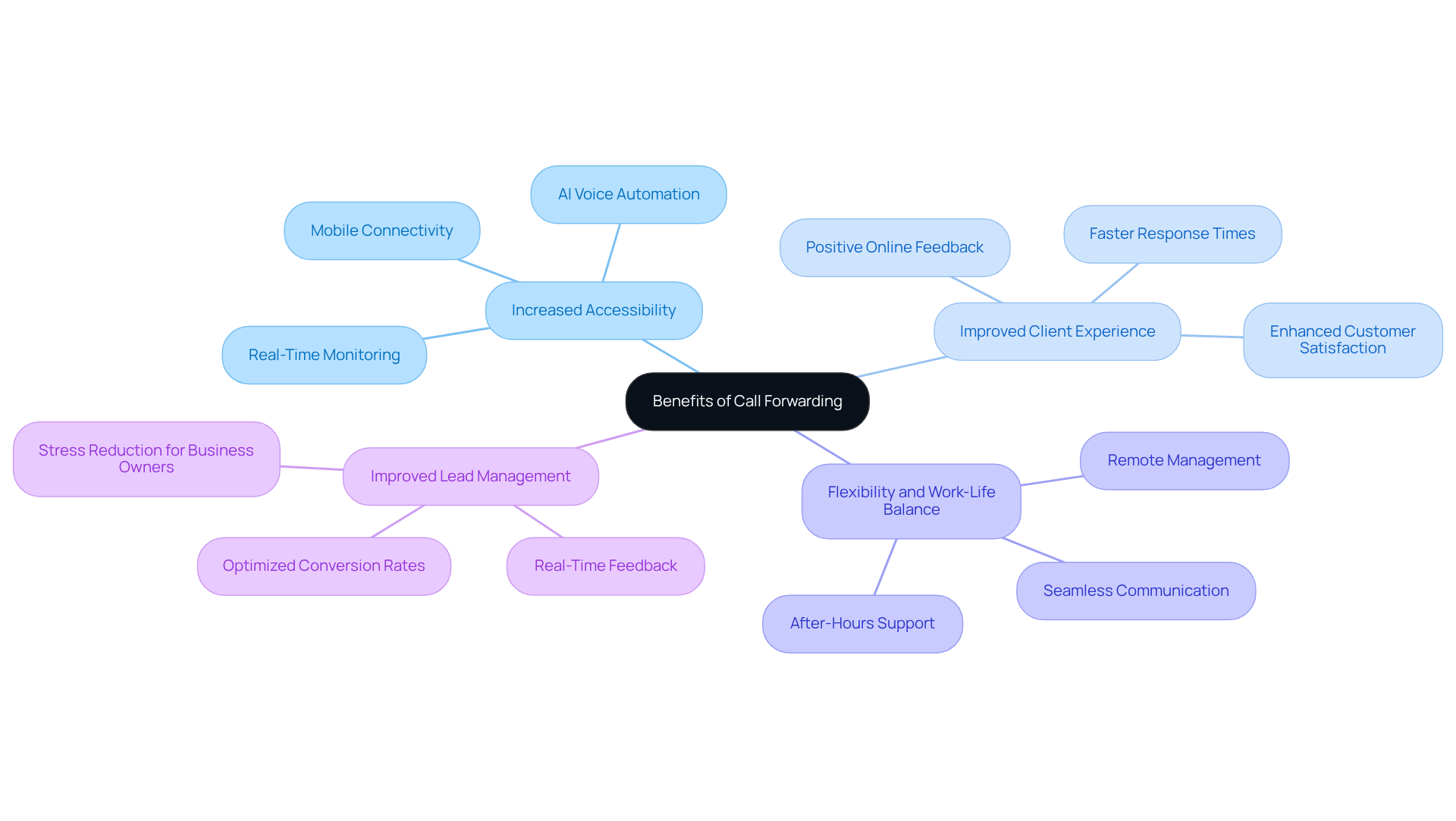Overview
This article delves into the myriad benefits and comparisons of various call forwarding options, underscoring their critical role for sales managers in enhancing communication effectiveness and fostering client engagement. It meticulously details how features such as unconditional, conditional, selective, and remote call forwarding can significantly improve accessibility, elevate the client experience, and optimize lead management. Ultimately, these advancements support robust sales strategies and substantially boost customer satisfaction.
Introduction
Call forwarding has emerged as an essential tool for sales managers aiming to elevate communication and responsiveness in today's dynamic business landscape. This article explores the diverse call forwarding options available, emphasizing their advantages and how they can be harnessed to boost sales productivity and enhance customer satisfaction. With a multitude of call forwarding types at their disposal, sales leaders face the critical task of identifying which option aligns most effectively with their specific needs and objectives.
Understanding Call Forwarding: Basics and Benefits
Call redirection is an essential telecommunication function that facilitates the transfer of incoming communications from one phone number to another. This capability is particularly beneficial for sales executives who must ensure prompt replies to prospects, regardless of their location. The primary advantages of call forwarding include:
-
Increased Accessibility: Sales teams can receive calls on their mobile devices or other designated numbers, guaranteeing they never miss an opportunity. This flexibility allows employees to maintain productivity while on the move, thereby enhancing overall team mobility. With Intone's AI voice automation, marketing teams can further improve accessibility by utilizing human-like AI that interacts with leads, ensuring that no opportunity is overlooked. Furthermore, the ability to monitor changes in key metrics empowers sales managers to respond swiftly to performance shifts.
-
Improved Client Experience: By routing inquiries to the appropriate team member, businesses can deliver faster responses to client questions, significantly enhancing satisfaction levels. Research indicates that efficient communication routing can lead to a substantial increase in favorable client interactions, fostering loyalty and repeat transactions. Intone's real-time analytics enable sales managers to oversee interaction performance and make rapid adjustments, ensuring engagements are not only prompt but also efficient. Companies implementing telephone redirection may witness a surge in positive online feedback due to enhanced customer support, as highlighted in client testimonials.
-
Flexibility and Work-Life Balance: Sales managers can manage communications from various locations, which is crucial in remote or hybrid work environments. This capability facilitates seamless communication, ensuring urgent queries are addressed promptly, even outside regular working hours. Call redirection also aids employees in managing work-related calls beyond standard hours, promoting a healthier work-life balance. With Intone's automated messaging and built-in integrations, sales teams can continue conversations and maintain engagement without the pressure of constant availability.
-
Improved Lead Management: The call forwarding options effectively route high-priority leads to specific agents, which optimizes conversion rates. By ensuring that the right individual handles each inquiry, businesses enhance their chances of closing deals and acquiring more leads. Intone's AI voice agents contribute to this process by providing real-time feedback and analytics, allowing managers to refine their strategies and improve overall performance. As noted in testimonials, efficient communication routing can significantly alleviate stress for small business owners, enabling them to focus on growth.
Understanding these advantages is vital for sales leaders aiming to leverage phone redirection as a strategic resource to enhance their sales methodologies and client engagement strategies. With proper execution, telephone routing not only streamlines operations but also significantly boosts customer satisfaction and revenue performance, especially when integrated with Intone's innovative AI solutions.

Types of Call Forwarding: Exploring Your Options
There are several types of call forwarding, each designed to meet different business needs:
-
Unconditional Call Forwarding: All incoming calls are forwarded to another number without any conditions. This method is essential for ensuring that no communications are overlooked, particularly for sales managers who must maintain consistent interaction with clients and prospects.
-
Call Forwarding Options: In this scenario, the call forwarding options allow calls to be forwarded only under specific conditions, such as when the line is busy or unanswered. This option is advantageous for effectively managing communication traffic. Research indicates that companies utilizing conditional forwarding can significantly enhance their response rates, with some reports highlighting increases of up to 30% in lead engagement.
-
Call forwarding options: This feature allows users to redirect communications from specific numbers only. Sales managers can prioritize communications from high-value clients or leads, ensuring prompt responses to key accounts. As Rory Whelan notes, "A lot of virtual phone numbers are set to run this way, and many businesses have benefitted from numerous virtual local or national telephone numbers routing to a single endpoint number."
-
Call Forwarding Options: This feature allows users to redirect communications to a number that is not linked to their phone line, which is particularly beneficial for remote teams. It ensures that team members can remain connected regardless of their location, facilitating seamless communication.
Understanding the call forwarding options empowers sales managers to select the most suitable transfer type that aligns with their sales strategies and client engagement objectives. For instance, EagleRider employed Nextiva's communication redirection features to ensure that inquiries to their primary number could be directed to their team in Las Vegas if the original line was offline or unanswered. This strategy allowed them to maintain exceptional customer service by ensuring that inquiries were addressed swiftly, regardless of the initial number's status. Furthermore, while these transfer types offer significant advantages, it is crucial to consider potential drawbacks, such as the risk of missing communications if transfer settings are not configured correctly.

Setting Up and Managing Call Forwarding: A Step-by-Step Guide
Configuring and overseeing call forwarding options is a straightforward process that can significantly enhance your team's responsiveness, especially when integrated with Intone's AI Voice Agents. Follow this step-by-step guide to optimize your communication strategy:
- Choose Your Telecommunication Transfer Type: Identify the category of communication redirection that best fits your requirements—unconditional, conditional, selective, or remote. Each type addresses different scenarios, ensuring that crucial communications are never missed.
- Access Your Phone Settings: Navigate to the settings menu within your phone system where call forwarding options can be found. This may differ based on your service provider.
- Enter the Forwarding Number: Input the phone number designated for forwarding communications. Ensure this number is active and consistently monitored to prevent missed opportunities.
- Configure Conditions: For conditional or selective redirection, define the specific circumstances under which communications will be redirected, such as when the line is busy or unanswered, by utilizing call forwarding options. This customization is vital for managing communication flow efficiently, and can be further enhanced by establishing data sources and transfer regulations through Intone's AI solutions.
- Test the Setup: Conduct trial connections to verify that the redirection functions correctly and that communications are directed as intended. This step is essential for ensuring seamless communication.
- Oversee and Modify: Regularly evaluate and adjust your telephone routing settings based on team performance and client feedback. Leverage smart analytics from Intone to monitor post-communication reporting and refine handling strategies.
By following this guide and utilizing Intone's adaptable AI Voice Agents, sales managers can significantly improve their communication processes, ensuring their teams remain responsive and effective in addressing client needs. Additionally, consider uploading your scripts, training resources, and conversation recordings to further tailor the AI agent to your business requirements.

Comparative Analysis: Pros and Cons of Each Call Forwarding Type
This analysis provides a comparative overview of the pros and cons associated with various call forwarding options, essential for sales managers aiming to optimize their communication strategies.
Call Forwarding Type | Pros | Cons
------------------------------|------------------------------------------------|------------------------------------------------
Unconditional Call Forwarding | - Guarantees no missed calls, ensuring constant availability for customer inquiries.
| - May lead to excessive communication volume, potentially straining resources.
Conditional Call Forwarding | - Reduces unnecessary call forwarding, directing only relevant calls based on predefined criteria.
| - Significant communications may be overlooked if settings are improperly arranged, which can frustrate clients; 36% of them consider the failure to address issues swiftly as the most exasperating aspect of poor service exchanges.
Selective Call Forwarding | - Prioritizes high-value calls, allowing sales teams to focus on leads that matter most.
| - Requires manual setup for each number, which can be time-consuming.
Remote Call Forwarding | - Provides flexibility for remote teams, enabling them to stay connected regardless of location.
| - May incur additional costs depending on the service provider, impacting budget considerations.
This analysis aids sales managers in evaluating their options and selecting the most effective transfer method tailored to their specific sales strategies and client engagement needs. With 86% of consumers willing to pay more for improved customer service, and noting that 61% of clients would cease transactions with a business after a negative service encounter, choosing the appropriate communication routing strategy is crucial for enhancing customer satisfaction and loyalty. Furthermore, call forwarding options can minimize the necessity for a dedicated team to redirect calls based on callers' needs, thereby streamlining operations and enhancing overall efficiency.

Conclusion
Call forwarding stands as an essential tool for sales managers aiming to elevate their communication strategies and enhance client engagement. By grasping the various types of call forwarding and their unique benefits, sales teams can guarantee their accessibility and responsiveness, ultimately driving increased conversion rates and customer satisfaction.
This article underscores significant advantages, including heightened accessibility, enriched client experiences, and superior lead management. It delineates different types of call forwarding—unconditional, conditional, selective, and remote—each tailored to address specific business needs. Moreover, the step-by-step guide accentuates the necessity of properly setting up and managing these forwarding options to optimize communication flow and bolster team performance.
In a fiercely competitive market, the strategic use of appropriate call forwarding options can profoundly influence a business's success. Sales managers are urged to assess their current communication strategies and contemplate the integration of advanced call forwarding solutions to enhance responsiveness, strengthen customer relationships, and ultimately amplify sales performance. By undertaking this initiative, they can cultivate a more agile and effective sales environment that meets the evolving demands of today's clients.
Frequently Asked Questions
What is call forwarding?
Call forwarding is a telecommunication function that transfers incoming communications from one phone number to another, allowing users to receive calls on different devices or numbers.
How does call forwarding benefit sales teams?
Call forwarding increases accessibility, enabling sales teams to receive calls on mobile devices or designated numbers, ensuring they never miss opportunities and can maintain productivity while on the move.
What impact does call forwarding have on client experience?
Call forwarding improves client experience by routing inquiries to the appropriate team member, leading to faster responses and increased client satisfaction, which can foster loyalty and repeat transactions.
How does call forwarding promote work-life balance?
Call forwarding allows sales managers to manage communications from various locations and handle work-related calls outside standard hours, promoting a healthier work-life balance.
How does call forwarding improve lead management?
Call forwarding effectively routes high-priority leads to specific agents, optimizing conversion rates and enhancing the chances of closing deals by ensuring the right individual handles each inquiry.
What role does Intone's AI play in call forwarding?
Intone's AI voice automation enhances accessibility and lead management by providing human-like interactions with leads, real-time feedback, and analytics, allowing sales managers to refine their strategies and improve performance.
What are the overall advantages of implementing call forwarding?
The advantages include increased accessibility, improved client experience, enhanced work-life balance, better lead management, and the potential for increased customer satisfaction and revenue performance when integrated with AI solutions.






